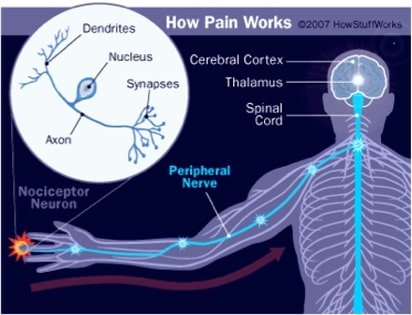July 25-31st is National Pain Week. We take a look at the causes of pain to better understand what pain is and how best to manage it.
‘Pain’ is our body’s way of warning or protecting us from something that is wrong or injured. We all suffer from pain every now and then but how we experience it may differ from person to person. It is important to understand what pain is and where it comes from in order to ensure adequate recovery.
What is Pain?
Pain is important – it tells us things not to do, for example walking on a broken ankle and it tell us to do things, for example take pain relief, rest or see a physiotherapist or GP.
How does pain work?

Our body is made up of a complex nervous system that includes nerves, the spinal cord and the brain (and a few extra components). The spinal cord and nerves provide a pathway for messages to travel around your body and to the brain. Floating around our nervous systems are small ‘sensor’ cells called nociceptors. These cells detect change throughout the body and help convey the message to the brain in the form of electrical impulses. They detect changes in touch or pressure, hot or cold and/or chemical changes. They are your body’s first line of call for protection against potential harm. The brain then determines that tissues are under threat and further action is taken. … therefore the brain determines whether or not you are suffering pain. The brain is also clever because it stores memories as well, which are important to remind you of painful movements that will hopefully protect you from doing it again in the future.
Your physiotherapist has a strong understanding of how the nervous system works and its function in the role of pain processing.
What are the types of pain?
The tissue generating the pain signal can categorize pain. The two main types are neuropathic or nerve pain and nociceptive pain caused by damage to non-nerve tissues.
Nerve Pain/ Neuropathic Pain:
- Pain, damage or disease that affects the nervous system.
- Can occur either by direct damage to the nerve or by a virus
Nociceptive Pain:
- Pain caused by damage to a body part. E.g. a muscle tear, torn ligament or broken bone.
- ‘Nociceptive cells’ detect problem and send signals to the brain via the spinal cord.
- Brain interrupts stimulus as pain and send response
○ Somatic pain à pain caused by injured structure.
○ Radicular pain à pain from irritation of nerve root.
■ Pain is sent in the distribution of the damaged/irritated nerve. Symptoms of radicular pain include weakness, numbness, pins and needles or loss of reflexes.
Pain can also be categorized by the length of time it has been present for and is called acute or chronic pain.
Acute Pain:
- Pain that typically lasts < 3 months
- Usually directly related to soft tissue damage (i.e. a sprained ankle)
- Generally resolves once injury has healed
Chronic Pain:
- Pain that lasts longer than > 3 months
- Often chronic pain is not related to damaged tissues or is out of proportion. This is due to changes in in the brain as a result of psychosocial and coping mechanisms. This type of pain is sometimes referred to ‘pain in the brain.’
- Often this type of pain can be ‘turned on’ by stimulus that tricks the brain into thinking the body is in danger. People suffering chronic pain often follows this vicious cycle and can take many months to improve.
- That is why it is so important to understand pain and seek management as soon as possible.
Managing Pain
The good news is there are many effective treatments to help you manage your pain. Your physiotherapist or medical professional will assist to choose the best treatment to suit the type of pain you have.
Physiotherapy Treatment:

- Manual therapy (including joint mobilisation, manipulation, massage, stretching, neurodynamics)
- Taping and/or bracing
- Exercise and strengthening
- Acupuncture and dry needling
- Addressing ergonomics and/or postural issues
- Heat and ice therapy
- TENs or Ultrasound therapy
Other pain management strategies:
- Pharmacological: Analgesics or Non-steroidal anti-inflammatory drugs (NSAIDs)
- Surgery
- Cortisone injections
- Heat and ice therapy

